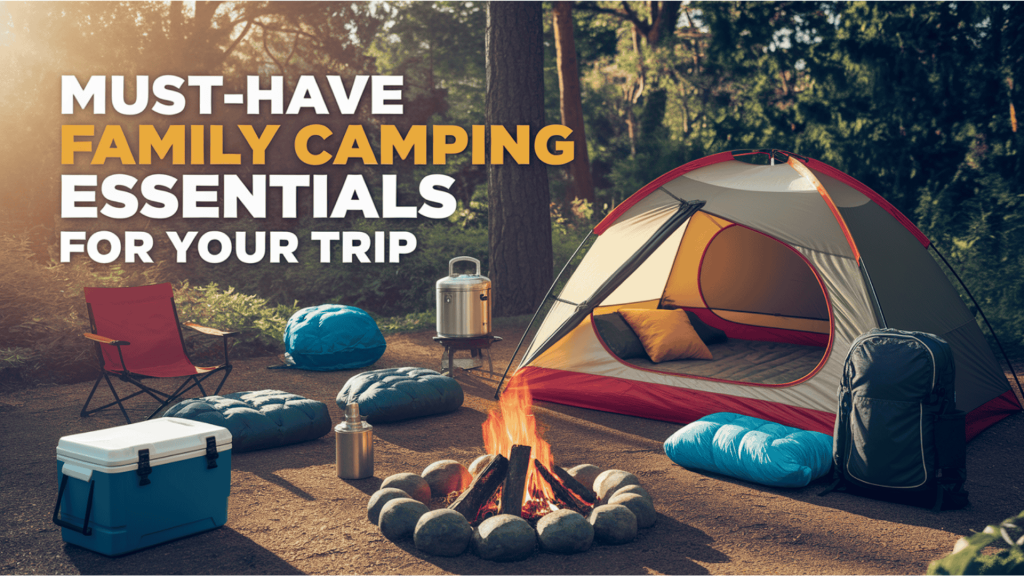Picture this: Stars twinkling overhead, laughter around a crackling campfire, and not a single “I forgot the…” crisis to ruin the moment. The secret to these magical family camping memories? Preparation!
Every seasoned outdoor parent knows that camping with kids transforms from potential disaster to incredible bonding when you’ve packed the right family camping essentials.
From that first sip of morning coffee as the mist rises off the lake to the cozy evening tucked into sleeping bags, your gear makes or breaks the experience.
We’ve tested, failed, and perfected the ultimate packing strategy so your family can focus on what truly matters: creating wilderness memories that last a lifetime.
The Basic Family Camping Gear You Can’t Forget
Your camping experience begins and ends with quality gear. Nothing ruins a family adventure faster than a leaky tent during a midnight downpour or shivering children who can’t sleep because their sleeping bags aren’t warm enough.
Start with investing in a spacious tent that offers breathing room—experts recommend 25-30 square feet per person. Look for models with separate rooms for privacy and sturdy materials that withstand unpredictable weather.
Your basic gear checklist should prioritize comfort and practicality:
- Family-sized tent with rainfly and footprint
- Weather-appropriate sleeping bags for each family member
- Sleeping pads or air mattresses (worth every penny and inch of car space)
- Extra tent stakes and repair kit (disasters always strike when least expected)
- Pillows from home for familiar comfort, especially for younger children
Don’t forget a battery-powered lantern for inside the tent and headlamps for each family member. These simple items prevent midnight stumbles during bathroom trips.
Essential Camping Gear: Tent, Sleeping Bags, Air Mattresses
Your shelter system deserves careful consideration. A quality tent should be easy to set up, water-resistant, and appropriate for your camping conditions.
For family camping, opt for a tent rated for 1-2 more people than your actual group size to ensure comfortable sleeping arrangements.
Importance of a Comfortable Tent & Sleeping Setup
Nothing undermines camping enthusiasm faster than a poor night’s sleep. Family-sized tents with room dividers provide privacy while keeping everyone close.
Select weather-appropriate sleeping bags with temperature ratings 10°F lower than expected nighttime lows for optimal comfort.
Quick Checklist: Tent, Stakes, Repair Kits, Pillows, Sleeping Bags
Double-check your shelter system before departure: tent body, rainfly, poles, stakes, and groundsheet.
Pack a repair kit with duct tape, extra cord, and patch materials for unexpected damage that could compromise your shelter in challenging conditions.
Cooking Essentials for the Whole Family

Creating delicious meals becomes both challenging and rewarding in the great outdoors. The right cooking setup transforms this potential stress point into a highlight of your camping experience.
Consider your cooking style before packing. Are you a one-pot meal family, or do you enjoy elaborate outdoor cuisine? Your answer determines what equipment deserves precious packing space.
Most family campers find a two-burner propane stove offers the perfect balance of simplicity and versatility. Pack a set of stackable pots and pans that nest together, saving valuable space.
Before leaving home, plan and prep your meals to minimize campsite work:
- Pre-crack eggs into labeled containers
- Pre-mix pancake batter in squeeze bottles
- Chop vegetables and store in reusable containers
- Package meat in marinade, then freeze to help keep your cooler cold
Clean-up becomes simpler with biodegradable soap and collapsible wash bins. Teach children the importance of proper waste disposal and leave-no-trace principles during this process.
PRO TIP: Pack meals in your cooler in reverse order—last day’s food on bottom, first day’s meals on top. This eliminates rummaging through a cold, wet cooler multiple times daily.
Outdoor Cooking Must-Haves
A reliable cooking system forms the foundation of successful camp cuisine. Choose between portable propane stoves for convenience, traditional campfires where permitted, or portable grills for that authentic outdoor flavor when preparing family meals.
Food Preparation and Cooking Tips
Plan simple, satisfying meals that require minimal preparation. Child favorites like foil packet meals, walking tacos, and campfire pizzas build excitement while minimizing cleanup. Always bring extra snacks—outdoor activities increase appetites dramatically.
Clothing and Footwear for Camping Comfort
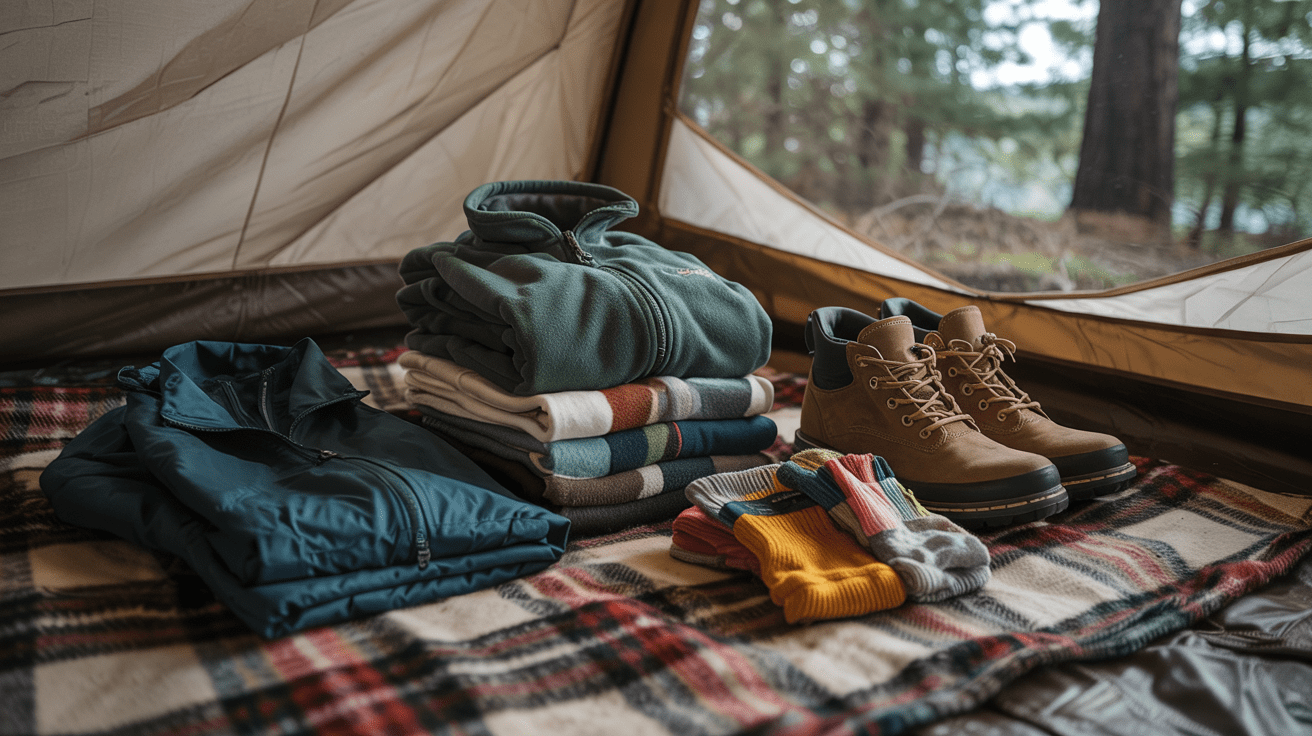
Appropriate clothing can make or break your camping experience. The outdoor environment demands versatility and preparation for changing conditions.
The layering system provides adaptability for fluctuating temperatures. Start with moisture-wicking base layers that pull sweat away from the body. Add insulating middle layers for warmth, and finish with waterproof, breathable outer shells for protection against rain and wind.
Everyone needs appropriate footwear for different activities:
- Waterproof hiking boots for trails and uneven terrain
- Water shoes for stream crossings and lakeshores
- Comfortable camp shoes for relaxing around the campsite
After a day of adventure, having dry, clean clothes to change into elevates everyone’s mood significantly. Pack at least one extra set of everything, especially for children who seem magnetically attracted to mud puddles and sticky marshmallows.
What to Pack for All Weather Conditions
Master the art of layering with moisture-wicking base layers, insulating mid-layers, and waterproof outer shells. This versatile system adapts to changing temperatures throughout your camping adventure. Always pack rain gear regardless of the forecast.
Packing for Kids: Quick-Drying Clothing, Extra Socks, and Comfortable Shoes
Children require special consideration when packing clothing. Quick-drying fabrics minimize discomfort after inevitable splashes and spills. Pack double the number of socks you think necessary—wet, dirty socks are camping happiness killers.
Personal Hygiene and Safety on the Campsite
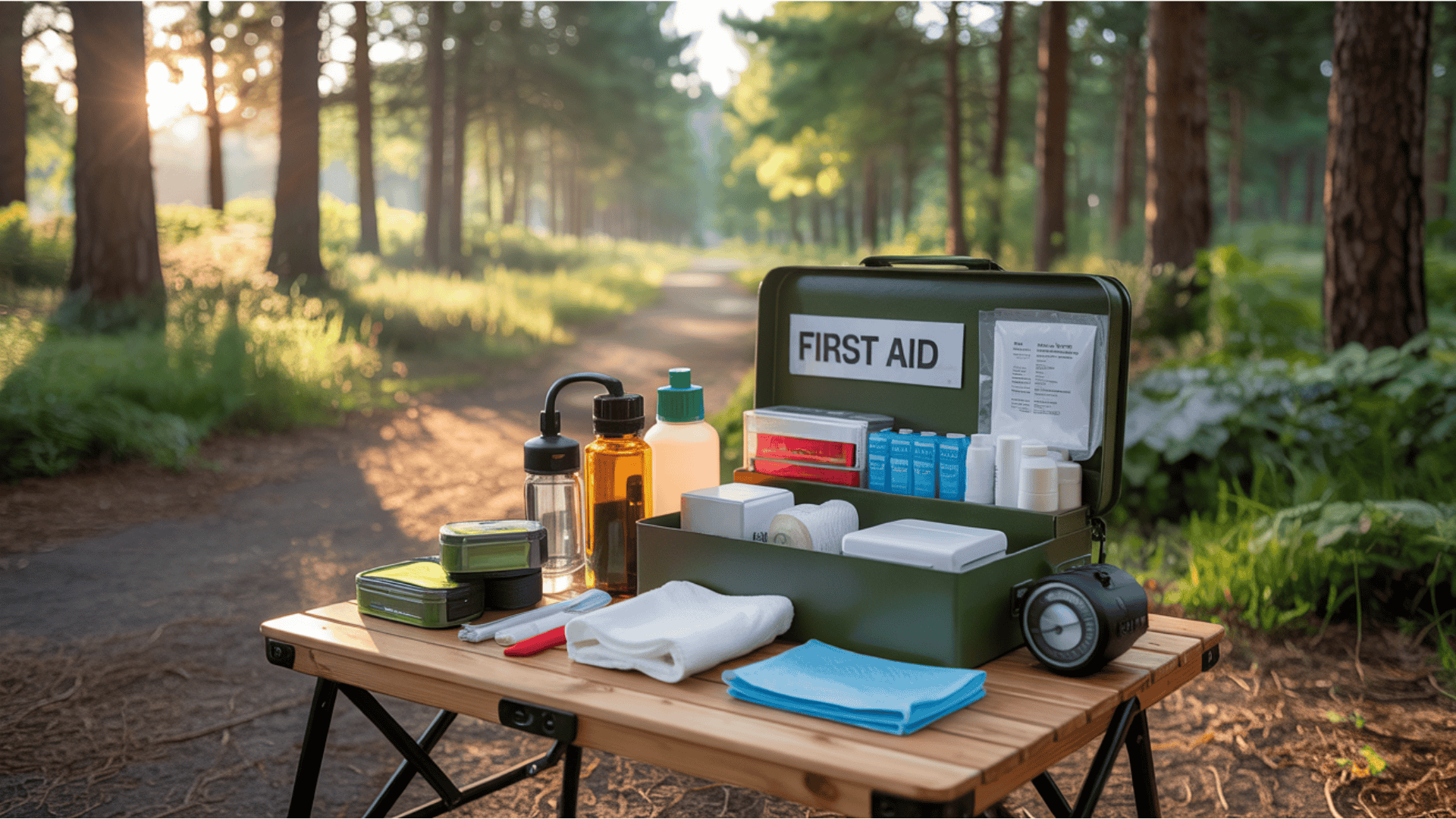
Maintaining basic hygiene and safety practices helps prevent common camping mishaps. Taking preventative measures ensures everyone stays healthy and comfortable throughout your outdoor adventure.
Simplify your hygiene routine by focusing on essentials. Biodegradable wet wipes serve multiple cleaning purposes when showers aren’t available. Hand sanitizer stations at the cooking area and near the bathroom facilities reduce illness transmission.
Create a dedicated first aid station at your campsite with supplies easily accessible to all adults. Cover the basics:
- Adhesive bandages in various sizes
- Antiseptic wipes and antibiotic ointment
- Tweezers for splinter removal
- Pain relievers are appropriate for all family members
Before your trip, discuss emergency procedures with everyone, including children at an age-appropriate level. Establish meeting points, teach whistle signals, and review basic first aid responses for common situations.
PRO TIP: Create personalized hygiene kits for each family member using zippered mesh bags. Include toothbrush, small toothpaste, and biodegradable soap. This keeps items organized and teaches children responsibility.
First Aid Kits & Personal Hygiene
Pack essential toiletries like biodegradable soap, toothbrushes, and multipurpose wipes. A small microfiber towel dries quickly between uses and serves multiple functions around camp. Include insect repellent and after-bite treatment for comfort.
Safety Items
Illumination becomes crucial after sunset. Equip each family member with a headlamp or flashlight with extra batteries. Place solar lights around trip hazards and mark pathways to bathroom facilities for nighttime navigation.
Outdoor Activities to Keep Everyone Engaged

Thoughtful activity planning prevents the dreaded “I’m bored” complaints. Balance structured activities with free exploration time for a well-rounded experience.
Morning hours work best for more strenuous activities like hiking when energy levels are highest. Save quieter activities like fishing or nature journaling for afternoons when temperatures peak and everyone needs downtime.
Create a camping activity bucket with age-appropriate options:
- Magnifying glasses and field guides for nature exploration
- Glow sticks for nighttime games
- Waterproof playing cards
- Simple craft supplies like colored pencils and nature journals
Don’t overschedule—part of camping’s magic comes from unstructured time for discovery and relaxation. Some of the best family moments happen during impromptu stream explorations or stargazing sessions.
Activities for Kids and Teens
Engage younger children with scavenger hunts featuring common campsite items and natural discoveries. Older kids enjoy more challenging activities like geocaching or building survival shelters. Classic outdoor games like frisbee appeal to multiple age groups.
Indoor Fun During Rainy Days
Prepare for inevitable weather disruptions with tent-friendly entertainment. Compact board games, playing cards, and mad libs provide screen-free enjoyment during rainfall. A deck of conversation starters sparks meaningful family discussions.
Additional Camping Essentials for a Relaxed Experience
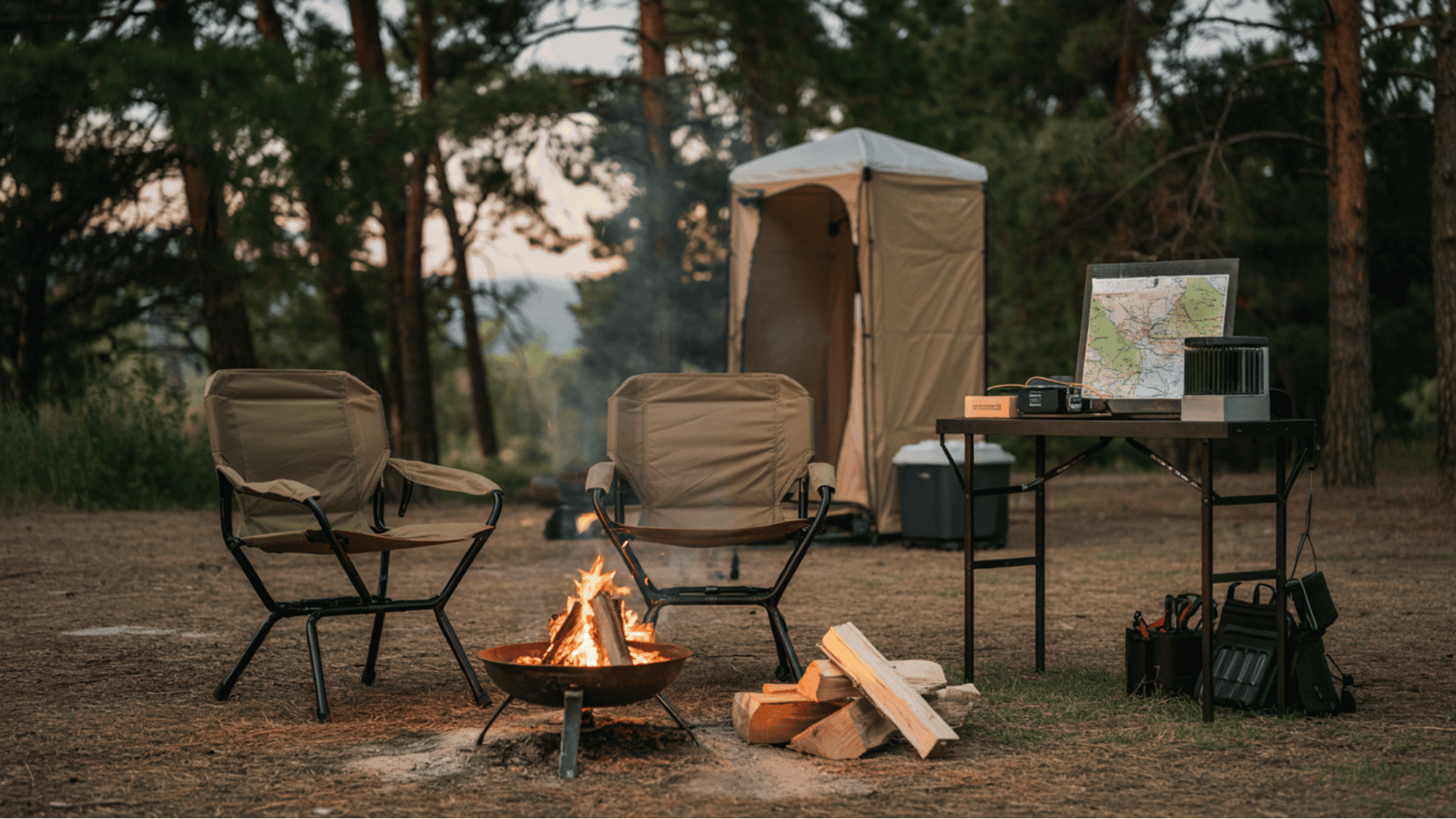
The difference between surviving and thriving outdoors often comes down to comfort accessories. These “nice-to-have” items transform your campsite into a true outdoor home.
Create comfortable gathering spaces with lightweight, packable camp chairs arranged around your fire pit or cooking area. A folding table provides valuable surface area for meal prep, games, and activities.
Consider privacy and weather protection needs:
- Pop-up privacy tent for changing or portable toilet
- Tarp or canopy for shade and rain protection
- Extra stakes and guy lines for securing everything in windy conditions
Power management requires planning for modern camping. Portable power banks keep essential devices charged, while solar chargers harness renewable energy for extended trips.
| ITEM | PURPOSE | PRIORITY |
|---|---|---|
| Camp chairs | Comfortable seating | High |
| Folding table | Food prep, activities | Medium |
| Shade canopy | Weather protection | High in summer |
| Hammock | Relaxation | Low (luxury) |
| Power bank | Device charging | Medium |
| Two-way radios | Communication | High with children |
Campsite Comfort Items
Transform your campsite into a cozy retreat with thoughtful additions. Packable camp chairs and a folding table create a functional living space, while overhead tarps provide essential protection from sun and rain for extended outdoor enjoyment.
Electronics & Communication
Balance technology use with nature immersion. Portable chargers keep essential devices powered, while two-way radios maintain communication when families separate for different activities. Keep a weather radio for emergency notifications.
How to Pack and Organize for Your Family Camping Trip
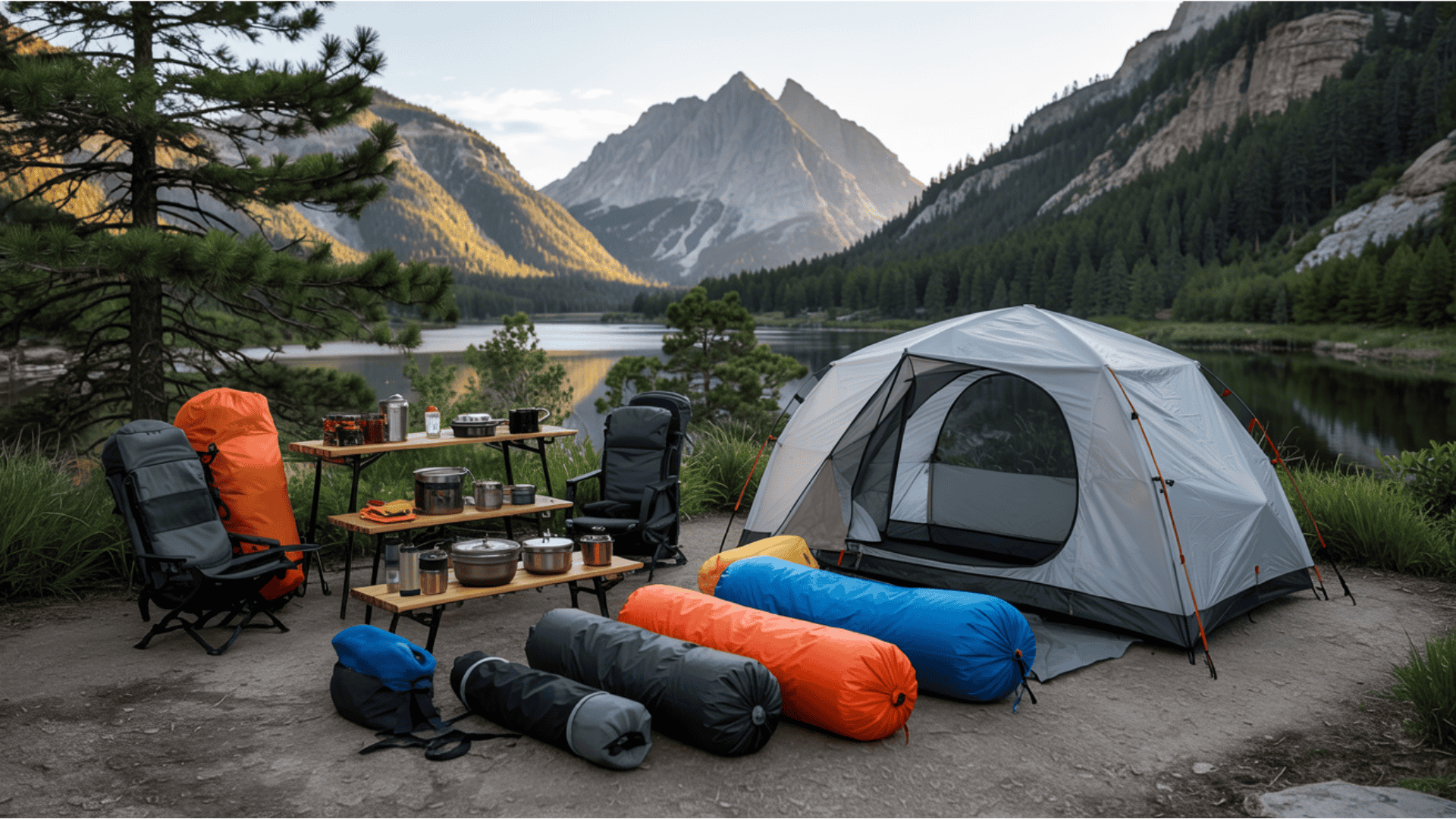
Efficient packing transforms chaotic loading and unloading into streamlined processes. Thoughtful organization systems make daily campsite living significantly more pleasant.
Invest in clear, stackable storage containers with secure lids for different categories of gear. Label each container clearly with contents visible from multiple angles. This system allows easy access to needed items without unpacking everything.
Before packing your vehicle, stage everything in your garage or living room:
- Group similar items together
- Identify redundancies and unnecessary items
- Ensure essential gear remains easily accessible
- Place frequently needed items near vehicle access points
This pre-packing review often reveals overlooked items and unnecessary duplications. It also creates a mental inventory that helps prevent the infamous “Did we pack the…?” questions halfway to your destination.
PRO TIP: Create a campsite map and packing list in a notebook. After each trip, note what worked well and what you wished you’d brought. This becomes invaluable for future adventures.
Packing Tips to Save Space and Reduce Stress
Maximize available space with strategic packing. Use compression sacks for sleeping bags and soft items. Utilize hollow spaces inside pots and coolers for smaller items like spice containers and utensils. Pre-pack meal ingredients by day in labeled containers.
Involving Kids in the Packing Process: Encouraging responsibility and fun
Assign age-appropriate packing responsibilities to children. Younger kids can gather personal items like stuffed animals and books, while older ones can pack their clothing.
Create personalized packing lists with pictures for non-readers.
Safety, Weather Prep, and Final Tips
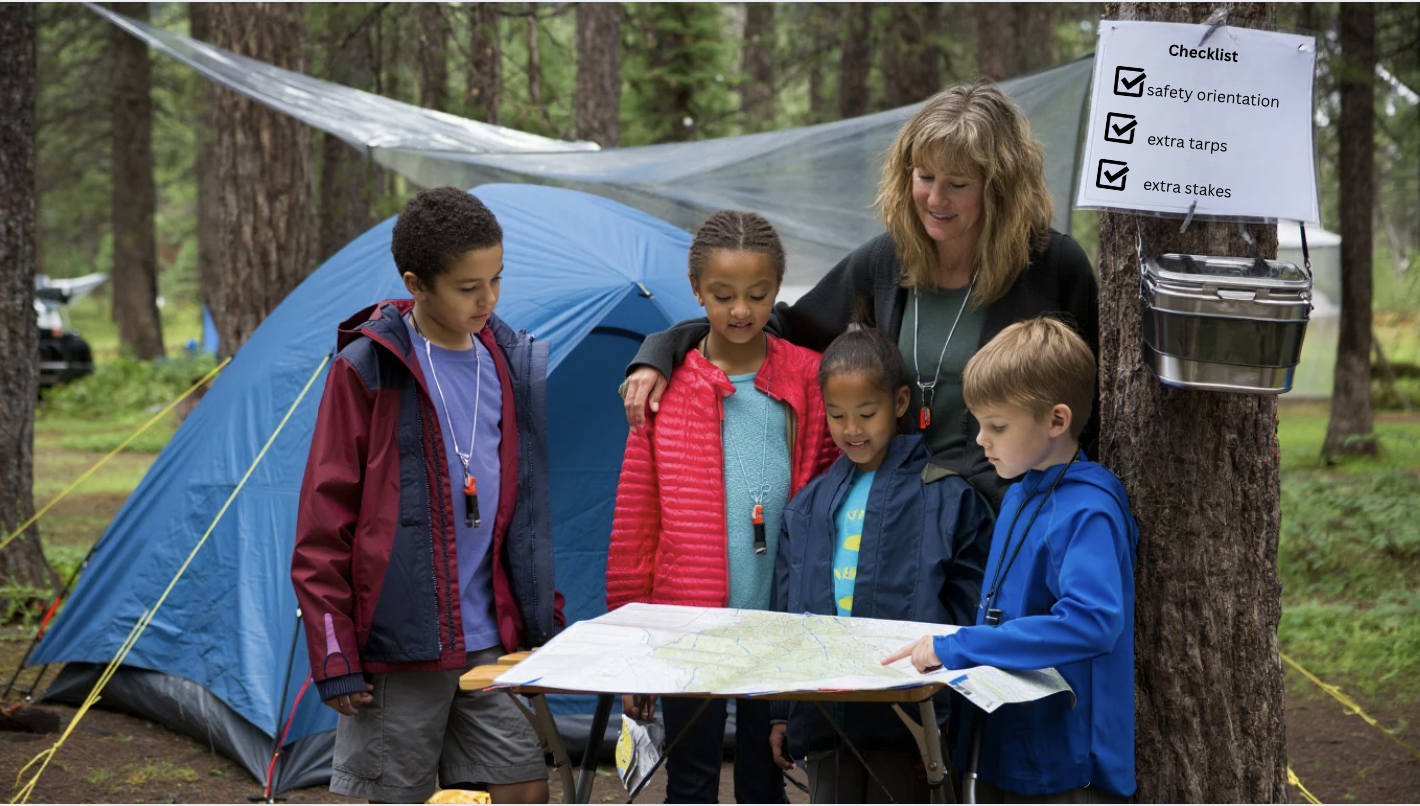
Preparedness for changing conditions ensures your family remains comfortable and safe regardless of what nature delivers. Knowledge and proper equipment create confidence when facing outdoor challenges.
Research your destination thoroughly before departure, noting potential hazards like wildlife, poisonous plants, or extreme weather patterns. Share this information appropriately with all family members.
Weather can change rapidly in outdoor settings, so prepare for conditions beyond the forecast:
- Pack clothing layers for temperatures 15°F above and below predictions
- Bring tarps and extra stakes for unexpected wind or rain
- Know where to seek shelter during severe weather events
Establish clear safety rules upon arrival, identifying boundary lines and off-limits areas. Create a buddy system for activities, ensuring nobody explores alone, regardless of age.
Preparing for Weather Changes
Weather unpredictability requires proactive planning. Pack versatile gear including waterproof jackets, extra tarps, and layered clothing options. Know how to properly stake and secure your tent for windy conditions. Have contingency plans for severe weather.
Safety Measures for All Ages
Establish clear campsite boundaries and buddy systems for all activities. Create age-appropriate rules for water safety, fire interaction, and wildlife encounters. Conduct a safety orientation upon arrival, identifying emergency meeting spots.
Bringing It All Together
The wilderness awaits your family’s footprints, stories, and laughter—and now you’re equipped with all the family camping essentials to make it unforgettable.
Remember, the most important item you’ll pack isn’t found on any checklist: it’s the mindset that embraces unexpected adventures and occasional mishaps as part of the journey.
Start with the fundamentals we’ve outlined, then adapt as your family develops its unique outdoor style. Your camping toolkit will evolve with each trip, gradually transforming from “survival mode” to “thriving mode.”
So pack up, head out, and watch as nature works its magic on your family bonds. The screens will fade from memory, but these shared adventures under open skies will remain your children’s treasured inheritance.
Don’t miss out—return for more vacation planning tips and off-the-beaten-path guides.

